photography
Archived Posts from this Category
Archived Posts from this Category
Posted by ben on 21 Sep 2009 | Tagged as: adventure day, arts organizations, photography, responses/reviews
I just posted my take on the Ansen Seale installation mounted by the Land Heritage Institute over at Glasstire. LHI is positioning itself at the intersection of a number of different issues and movements, potentially functioning simultaneously as a park, an educational resource, an equestrian center, an advocacy group, a think tank and an art center. It should be interesting to watch how the whole thing plays out — the series of events that led it to where it is today has not exactly been predictable, and I doubt its future development will be either. In any case, I’m looking forward to LHI’s “art-sci symposium” The Nature of Place next month. With participants like Sandy Stone, Lucy Lippard, Erik Knutzen from the Center for Land Use Interpretation, and Anjali Gupta from Art Lies, it should be interesting to say the least. We’ll keep you posted.
Posted by ben on 24 Jun 2009 | Tagged as: arts organizations, books, conceptual art, coverage, design, photography, responses/reviews
Dan Goddard, the Express-News’ long-time art critic who was recently canned in a round of layoffs, has just published two good articles dealing with Linda Pace properties. In the San Antonio Current, he discusses the fate of Pace’s storied art collection, and it’s forthcoming permanent home. Designed by British architect David Adjaye specifically for the Pace collection, the project is on hold due to the economic downturn. Apart from that news, which I’ve been hearing unofficially for a while, Goddard reveals many interesting tidbits about the collection, Linda’s personal relationships with various artists, and the ongoing activities of the foundation. I was excited to learn that the Linda Pace Foundation is funding a public work by Jesse Amado to be installed at the downtown library (it will surely be a welcome contrast to their Chihuly).
On Glasstire, Goddard reviews Jonathan Monk’s “Rew-Shay Hood Project Part II” at Artpace. There’s some good context here for understanding the subtleties of the show, from Monk’s history with appropriation to Rucsha’s Catholic background, right down to curator Matthew Drutt’s obsession with vehicle-related art. That Goddard brings up Dave Hickey’s discussion of Ruscha is interesting, given Hickey’s interest in custom cars as an artistic medium. Some people I’ve talked to about the show come away with the impression that Monk is having the Ruscha photos painted on car hoods from the same period; Goddard points out this isn’t the case, the hoods come from one or two decades later than the photos. Perhaps what’s going on here is a contrast between the beginning of the idea of an “artist’s book” (the move away from the artist creating singular, unique objects) and the end of the era of the custom muscle car. As Goddard points out, the push for more efficient, less polluting cars using computer technologies pushed out custom car hobbyist culture to a large extent. But the rise of these computer technologies also empowered artists to move into their own mass production, at the same time allowing the kind of appropriation that Monk himself uses. Although Ruscha wasn’t using computers to produce Twentysix Gas Stations (and I don’t know if Monk used them in his reproductions), they are the descendents of the mass-production technologies that printed Twentysix Gas Stations, and Monk’s relevance certainly has a lot to do with them. Thus in the show we have the suggestion of a kind of ebb and flow, technology and the markets at certain points inspiring very personal expression, at other points depersonalizing art even to the point that it becomes design. And isn’t Monk here acting more like a designer than an artist, if by design we mean depersonalized visual communication?
Posted by aaron on 17 Jun 2009 | Tagged as: adventure day, art paparazzi, celebrity sightings, music, party photos, photography, rock!, video/film
No audio. Play simultaneously for best effect.
Galactic Center of Milky Way Rises over Texas Star Party from William Castleman.
Brooklyn’s Stars Like Fleas (featuring SA-town homeboy Ryan Sawyer on drums and lead beard) play a PopRally event at MOMA on June 8, 2009 – shot and edited by Austin Rhodes.
[hattips to albert flores & cosmo inserra for the first and ryan sawyer for the second.]
Posted by ben on 02 May 2009 | Tagged as: arts organizations, photography, possibilities, responses/reviews
Just back from New York, and I must say I agree with Holland Cotter that it’s enlightening to see the Met’s “The Pictures Generation” show alongside the New Museum’s “The Generational: Younger than Jesus.” I also agree with him that the former is a much stronger and more carefully curated group of work than the latter. But at the same time, I don’t think it’s quite right to say that the “generational parallels are so many as to be worrisome. Has new art come no further than this? Is it still tilling fields all but farmed out in the past?”
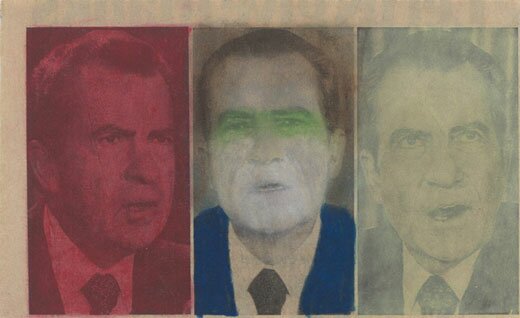
One reason to question this reductive view of current appropriation-driven art is articulated well in an article by Jan Verwoert published a couple of years ago in Art & Research. In it, Verwoert makes a distinction between the appropriation art that was produced in the 1970s and ’80s (see “Untitled (Nixon)” by Paul McMahon above), and another kind of work that emerged in the 1990s. The younger group of artists employ similar strategies as their predecessors, but with different implications. The basic premise is that during the Cold War history had frozen due to a superpower stalemate, and artists such as Robert Longo and Cindy Sherman analyzed culture through the lense of a detachment from history. In the ’90s the movement of history sprang to life again, and the act of appropriation became something more like the act of invocation: “To utter words for the sake of analysis already means to put these words to work. You cannot test a spell. To utter it is to put it into effect.” Artists had to wrestle with the ghosts of the past (a “multiplicity of histories”) as well as the life of the moment, as they dealt with a quickly evolving relationship to history and its connections to the present.
It seems to me that since 2001, this sense of living in a web of histories has only accelerated: from September 11 to Obama, China’s waxing cultural influence to the perpetually imminent collapse of Pakistan, commentators are stumbling over themselves to declare the dawn of new era after new era. It has the urgency of the 1960s, even if the cultural shifts are of a different nature. The ’60s produced a large body of art — both Pop and Conceptual — which resisted metaphor and was later synthesized by the ’70s “pictures generation” artists. But at the same time that this work resisted metaphor, it simultaneously helped open up space for a reinvigoration of metaphor and symbolism, a space that was filled by artists from Kenneth Anger to Martin Luther King (see “” and “I’ve Been to the Mountaintop“). Our moment now is different from the ’60s in many ways, but I think we are seeing a similar opening for a resurgence of the poetic, largely lacking from the artwork of “the pictures generation.”

So while I found the pieces at the New Museum generally stale and incoherent (see “Deep Breathing” by Cao Fei above), it’s not because the artists are simply rehashing Barbara Kruger or Jack Goldstein. It’s because the artists in the show generally don’t meet the poetic demands of the moment. They’re caught, unable to take the extra-historical viewpoint of their ’70s counterparts, but unwilling to make the poetic commitments of earlier artists. That’s not to say that other young artists aren’t invoking the past with an incantatory symbolization: it’s just not apparent in the vast majority of the pieces in “Younger than Jesus.”

Aaron Curry’s sculptures and prints (see “Cosmic Knot #2″ above) at Michael Werner wove found material and invocation of modernist artworks together in a way that revealed, in the words of Bruce Hainley, “an artist who wishes to make thrilling rather than pernicious the attempt to wrest from the global barrage something inappropriable, irreducible, and questioning, which acknowledges what comes before it, culturally, and from where it arrives without merely desecrating it.” I sense in Hainley’s words (which come from the catalog for the show) a suggestion of the kind of invocation Verwoert proposes. Curry’s show is a thriller, raising the spectre of modernism dwelling somewhere in the water of our reservoirs — not as a chilling memory, but as a living ghost prepared to inhabit our fields, our livestock, our bodies.
UPDATE: This interview with Bruce High Quality Foundation in Art in America seems too pertinent not to add here. From the discussion of Sept 11 as their “creation myth” to the invocation of multiple histories, there are a lot of parallels between this post and the interview. Although I visited the Bruce High Quality studio during my trip, their recent show had just come down, so I missed their new work both in the gallery and in the studio — otherwise they may have made it into the original post.
Posted by justin on 26 Feb 2009 | Tagged as: adventure day, announcements, art paparazzi, borders, photography
Last Friday night I was assigned a real doozy of an assignment for the San Antonio Current, Wrestling 4 Christ (..errr warriors 4 christ?) an event that sits in a church parking lot and claims to both spread the word of Jesus Christ, and offer free live wrestling to the community. Since that story and those images have yet to go to print, I’ll refrain from posting them here. While waiting for the event to begin, I noticed a tall skinny blond guy, looking a little bit out of place with the crowd, walking with a pad and pencil in hand. Not sure yet who was writing the wrestling story, I quickly scanned my internal archive of SACurrent writers who I’ve met or seen in person, and came up blank. After sitting a little to far away from all of the gathering crowd, I decided to make my way closer and maybe see what kind of christian wrestling gossip I could catch up on. I found a rock wall to lean on a hundred feet from the ring, turning my head, I noticed the writer who I had previously thought to be out of place. I asked him who he was writing for and he said something to the effect of, nobody, himself, a comedy book, etc.. He was from Britain(the Isle of Wight), and had just gotten to San Antonio the day previous. He mentioned that he had come to town just for the wrestling event, and I thought for a second he must be a real religious wrestling zealot. After continung our discussion, I decided there was no way he could really be that much of a kook, he seemed pretty level-headed really… what was the deal? Johnston walked up (the SACurrent writer for the story) and I soon lost track of my discussion with Adam. We all turned our attention to getting inside of the backstage trailer full of Christian wrestlers. Once inside, coated in the dank smell of sunday school portable turned middle school locker room, Johnston asked Adam specifically what the book he was writing was all about and if he had a publisher? In a quiet way Adam tells us he is the maker of “The Girl of My Dreams.com,” and had embarked on a worldwide hunt for a girl he woke up one morning and drew a picture of after seeing her in a zombie killing dream. He had received some sort of lead that his girl might be here, in San Antonio, at the Wrestling 4 Christ event. What a journey! Me and Johnston felt ridiculous elation at meeting such a one-off traveler. He was leaving in the morning, on a train to Washington. He was even wearing a neon green wrestling jumpsuit under his clothing, perhaps to flag her down? Finally, He mentioned to us the connection between his website, and “the NY Girl of my Dreams guy, who broke up with his dream girl after only 2 months..” and what he thought of that, “..Lame, wheres the story in that?”
I left Adam after watching most of the wrestling, my girlfriend wanted to get dinner, and I had the shots I needed. Wrestling, even the pseudo-safe Christian type makes me squirm to watch. I’m such a pacifist, I stand there watching, cringing in pain and thinking to myself, “isn’t somebody going to stop that guy?” Adam seemed to think I was going to miss out, and Johnston got some fabulous quotes out of the backroom sweaty guys for the upcoming story.. I don’t think I’ll ever understand what the draw is..but I hope it gets Adam one step closer to his Dream Girl.
Posted by thomas-cummins on 09 Jan 2009 | Tagged as: cellphonevideo, photography
Here is an Austin blog that focuses on the fine art of camera tossing. Our neighbors to the North are part of a recent fad that can be found popping up around Flickr which involves breaking the cardinal rule of protecting your camera at all costs. Most of these particular examples remind me of the iTunes visualizer and who knows where this type of movement will lead to but I think it’s safe to say that it will be around forever as cameras just get cheaper and more disposable. Next time a telemarketer or your ex calls on your cell – just be sure the camera is on before you throw it across the room.
Posted by ben on 18 Nov 2008 | Tagged as: photography

Logs jamming Kemi River during general strike (Photo by Mark Kauffman for LIFE Magazine, 1949)
A friend turned me on to the fact that Google is hosting over 10 million images from the . Enjoy.
[cross-posted at Scattered Work]
Posted by ben on 03 Nov 2008 | Tagged as: party photos, photography, r.i.p.
From Franco Mondini-Ruiz’s lavish Dia de los Muertos party at his westside wonderland estate, a cake for Mr Danny Geisler:

[Cross-posted at Scattered Work]
Posted by justin on 21 Jul 2008 | Tagged as: art + bikes, art paparazzi, image & sound, performance art, photography, renegade performances, video/film
Posted by ben on 10 Jul 2008 | Tagged as: adventure day, design, graffiti, net.art, photography
An old friend sets out to chronicle New York City through its ATMs on a new blog, aptly titled :
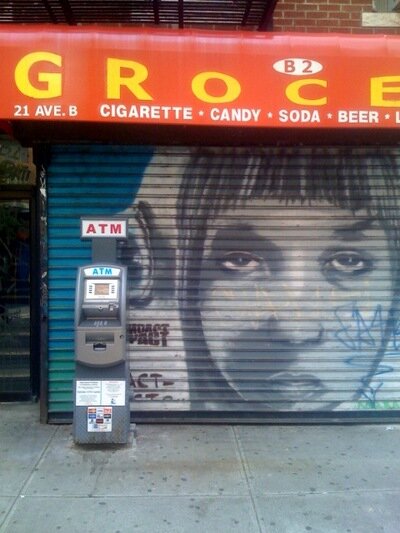
UPDATE: ATMNYC’s author writes:
The photos on atmnyc are taken with my iphone and then emailed directly to the tumblr blog. So the pictures are all snapped and posted in almost the same instant. I like to think of it as a sort of updated polaroid style. The limits of the iphone camera, the problems with focus, the tendency to blur and glare, even the dimensions of the photo, actually remind me a lot of the old Polaroid Land Camera.
I do not photograph any indoor atms unless they are visible from the street. I take many of the pictures quickly from my bike. I make little effort at composition— the city takes care of that part itself.
I used to hate the sight of atms, thinking that they were a regrettable intermediary techno clutter, not unlike the cell phone towers tacked onto so many historic Manhattan apartment buildings. On the other hand I find payphones charming, perhaps because they are nearing their obsolescence. Likewise, New York’s rooftop water towers are beautiful appendages, so maybe cellphone towers should be indulged as well.
In any case, I’ve become fond of atms, and have come to see them as helpful little droids, standing on corners blinking their senseless cyclopes eye, waiting patiently to serve the needs of a passing master– for a small fee, of course. In the meantime they are heaped with every abuse offered by graffiti, violence and the weather.
But despite my growing sentimentality for the things, I still get my cash from the teller at a local branch bank.
Posted by ben on 01 Jul 2008 | Tagged as: acquisitions, adventure day, arts organizations, design, photography, politics, public art
It was closing time at my neighborhood bar, the three of us leaning on a concrete table surrounded by cactus, when I heard about the dumpster full of art. A large scale public mural by Anton Vidokle was in the process of being removed by a company which had bought the building. The mural, an application of 100 vinyl decals on metal panels, depicted simplified versions of logos from bankrupt companies. Now the panels were being removed and thrown in a dumpster in the parking lot next to the building.
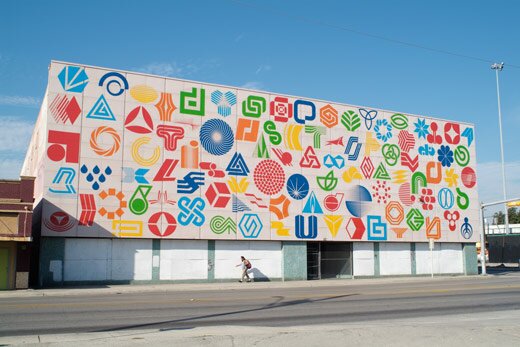
Installation shot of 100 Bankrupt Corporations (public geometry) by Anton Vidokle (courtesy Artpace)
We finished our beers, jumped in the car, and headed downtown. When we found the dumpster at around one in the morning, we realized immediately that we weren’t the first San Antonio art scenesters to have this idea. While almost all of the panels had been removed from the building, only a dozen or so were left in the dumpster. We jumped in and started throwing our favorites out into the parking lot. After cramming as many as we could into the trunk of the car, we took off, leaving a few for any other art scavengers who might not look down their noses on dumpster diving. After installing a panel with red semi-circular fragments of anonymous logos in my living room, I started noticing the other pieces around San Antonio. Stacked up near studios, hanging on workshop walls, leaning up against houses, they spoke of something just out of reach. Over the course of their lives, from symbols of production and commerce which drowned in a sea of such symbols, to their resurrection as material for an intricate yet minimal public mural, and finally to their cold, arbitrary fragmentation along the lines of a surface grid, they moved from abstraction to abstraction, carrying bits of identity from place to place.
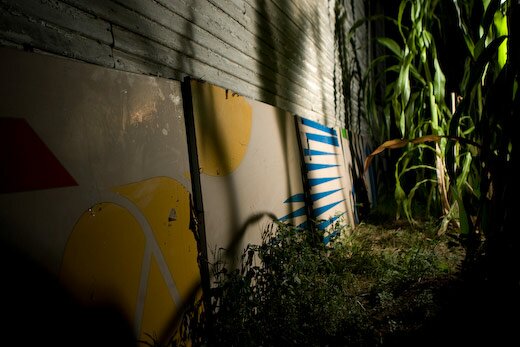
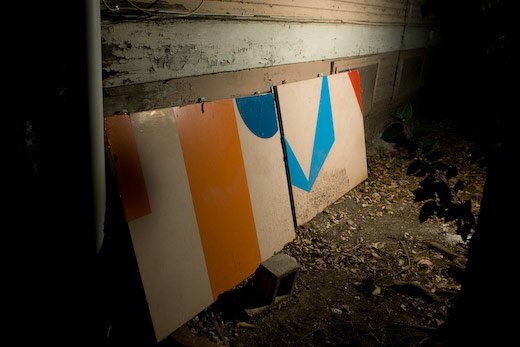
Photos of Vidokle panels in the wild by Justin Parr
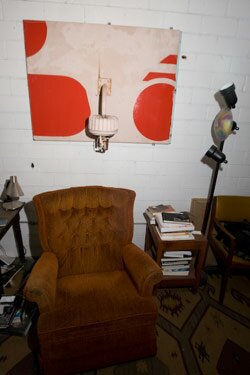 For a long time I waited for the few remaining panels along the top and down one side of the building to be removed. Every time I drove down San Pedro I looked to see if a few more of these public geometries had been taken from the face of the building, if perhaps the dumpster might have a few more treasures in it. And for a long time nothing happened. The building remained unchanged. After some months I forgot about the few logos that remained in their public home, and the mostly-deconstructed facade slowly slipped into the background of my focus.
For a long time I waited for the few remaining panels along the top and down one side of the building to be removed. Every time I drove down San Pedro I looked to see if a few more of these public geometries had been taken from the face of the building, if perhaps the dumpster might have a few more treasures in it. And for a long time nothing happened. The building remained unchanged. After some months I forgot about the few logos that remained in their public home, and the mostly-deconstructed facade slowly slipped into the background of my focus.
Then one day it was gone. Not the facade, the panels that were always too exentric to remain for long, but the building itself, which had been reduced to a heap of rubble. A slight controversey ensued, but that too will slip from the front of our minds before long. Still, these little pieces of the mural endure, reminders of the simplified, fragmented memories we collect from our meanderings through the city; reminders of the sometimes crude identities we carry with us, and the ways they can be resurrected, transformed, annihilated.
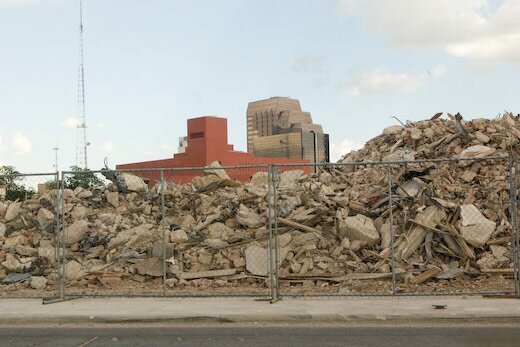
Photo of Jorrie Furniture Building rubble by Justin Parr
Posted by ben on 16 Jun 2008 | Tagged as: arts organizations, photography, responses/reviews
Tyler Green points to posts by Daniel Drezner and Barry Gewen regarding the fate of the public intellectual in recent years. Drezner argues that, partly thanks to the blogosphere, the pool of public intellectuals is as strong as ever. Gewen thinks Drezner’s playing fast and loose with the term “public intellectual” — and in some cases I’m inclined to agree. I would consider Joshua Micah Marshall and several others on the list to be dedicated political analysts, although I think other names on Drezner’s list do make the cut (Christopher Hitchens and Andrew Sullivan, for instance).
At any rate, Green brings up the question of how many public intellectuals spend much time talking about visual art these days, and I think he’s right that the answer would be “not very many” (although I see no reason Dave Hickey couldn’t slip into Drezner’s list). But his explanation for this fact — that art critics “tend to burrow and bunker into the safe little cocoon of the art world, rarely engaging issues, ideas outside the ghetto” — needs some unpacking. It’s true that the visual art world can be insular in a lot of ways. I think part of the reason for this is that it is one of the few creative communities that has not embraced mass production in a comprehensive way. A work of visual art, unlike a typical book, album, or film is almost always limited in quantity. When it’s not (see Felix Gonalez Torres), it’s usually to make an abstract point about materiality or something. Even artists who use inherently reproducible media (e.g. photography) artificially limit their works to editions, apparently in order to remain within the prescribed economic structure of the art world. This makes the underlying structure of the art world inherently elitist.
But I think there’s another, perhaps more meaningful reason that the visual arts are rarely part of a broader public discourse (after all, every form of intellectualism tends toward elitism). While Green says that visual art “rarely engag[es] issues, ideas outside the ghetto,” visual artists work hard to embrace other disciplines and incorporate them into their toolbox. There has been a steady trend of breaking down these barriers between art forms at least since Duchamp. But, counterintuitively, this very openness has bread insularity. When a visual artist incorporates a technique from the music world, or an idea from the political realm, it is to build it into an esoteric conceptual structure. It’s rare for a contemporary artist to deal with an outside idea on its own terms — it’s more common to appropriate the idea or image and use it to comment on the art-historical tradition. This Talmudic labyrinth usually doesn’t yield much of interest to the broader public discourse.
Now I don’t mean to imply that artists have nothing to contribute to a broader conversation. Far from it. But for a public intellectual to engage with the art community in a meaningful way, they’re going to have to cut through many layers of irrelevant meta-discussion to get to the heart of the artistic statement. At a certain point, they’ll realize that they could more easily broaden their field of useful knowledge by studying economics or film.
Posted by ben on 05 Jun 2008 | Tagged as: graffiti, photography, silliness
The lengths people go to to keep street art fresh (personally, I’m a bigger fan of the Indian Justin posted last week):

[via]
Posted by ben on 04 Jun 2008 | Tagged as: announcements, celebrity sightings, photography
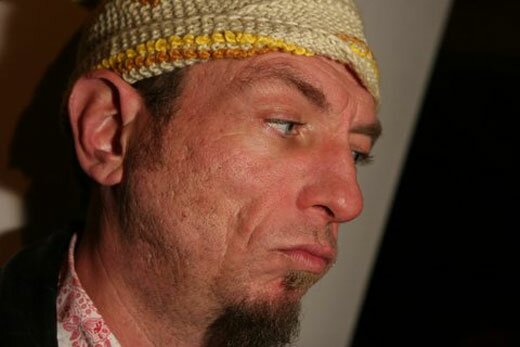
(photo by Justin Parr)
Everyone here at Emvergeoning sends our best wishes to local art star Chuck Ramirez, who will be having open heart surgery this week. Doctors discovered late last week that his aorta has swollen to an astonishing 10 cm due to a congenital heart defect. A couple of Chuck’s pieces after the jump for those who aren’t familiar (more here).
Posted by ben on 31 Mar 2008 | Tagged as: design, net.art, photography, poetry, politics
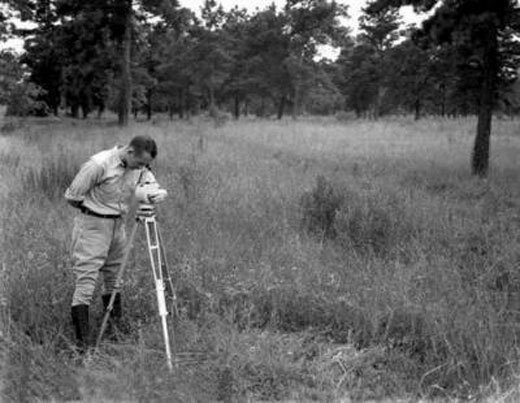
is a new blog by an old friend and occasional collaborator, publishing research he has conducted over the past year or so. You may find that it bears a certain affinity to Emvergeoning’s comment section, being a poetic collage of anachronistic media. Enjoy.
Posted by ben on 18 Mar 2008 | Tagged as: design, photography, silliness
Check in with Photoshop Disasters, a new blog documenting the travesties arising from careless use of the clone tool and other weapons in the photo “retouching” arsenal. Naturally, they mostly involve adding, removing, and distorting women’s body parts, as well as a few unruly hands. [hat tip]
Posted by ben on 27 Jan 2008 | Tagged as: photography, vs.
The photographic archives surrounding two iconic war images have recently been discovered. In December of 2006, the Wall Street Journal tracked down the anonymous photographer of a Pulitzer-winning photograph of a 1979 execution in Iran. Now we learn that a suitcase full of negatives by Robert Capa of the Spanish Civil War have been discovered in Mexico City.
These two images have kept people searching for decades, trying to the find the stories behind the photos:

1979 Iranian Execution by Jahangir Razmi
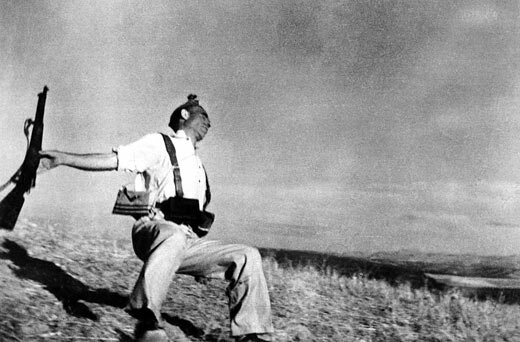
The Falling Soldier by Robert Capa (Spanish Civil War)